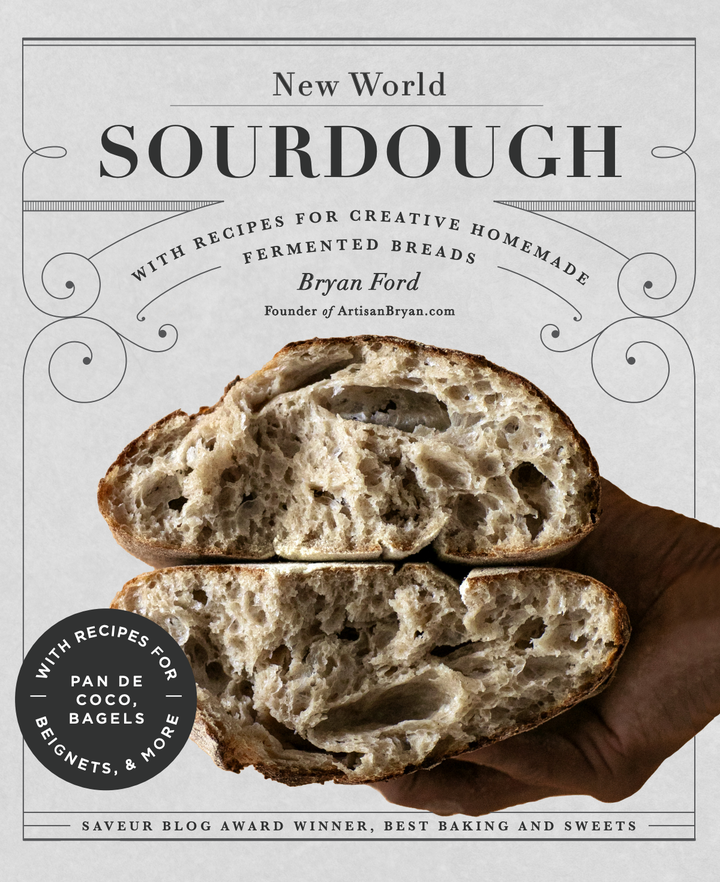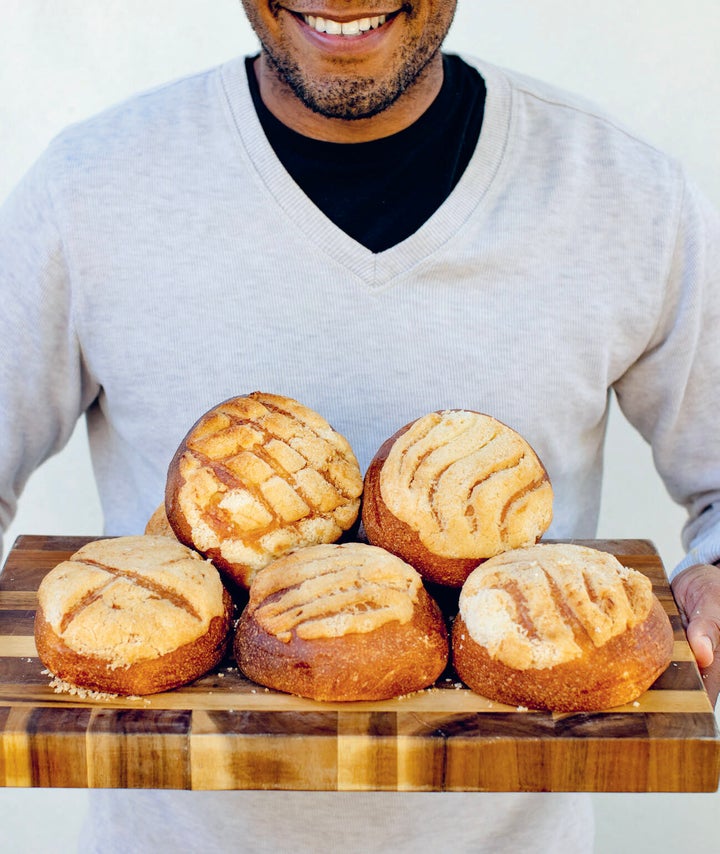
About a year and a half ago, Bryan Ford was working overnight shifts at Sullivan Street Bakery in Miami, making $13 an hour while blogging for his baking website on the side.
Then, during the pandemic’s bread-baking frenzy, his blog traffic exploded, and his first cookbook, released this summer, sold out its first printing. “New World Sourdough” honors Ford’s Central American roots with sourdough-based recipes for semitas de yema, pan de coco and flour tortillas made with coconut milk.
The child of Honduran immigrants, Ford was born in the Bronx and grew up in New Orleans, where eating his mother’s baleadas ― tortillas filled with red beans, cream and queso fresco ― was a regular part of his childhood.
As Ford progressed from home baker to professional, he initially tried growing his following on social media the way other bakers had ― by undertaking a “period of straight crumb shots” on his Instagram. “Loaf cut in half, the classic open crumb,” he said. “I was really trying to be one of them.”
But in fall 2018, Ford’s mother came to visit, and he decided to experiment by baking pan de coco, a Honduran treat from his childhood, with sourdough starter that added natural leavening. “It was kind of sweet. It was soft. I made this video and it got reposted to big accounts and people flooded the comments, like, ‘Where’s the recipe?’” he said. That led him to create his website, artisanbryan.com, where he shared his version of pan de coco.

It also marked a shift in his mindset from prioritizing airy crumb shots to helping others expand their ideas of what baking can be. The cover of “New World Sourdough” is a photograph of a sourdough loaf ripped in half in Ford’s hands, and that’s the message Ford wants to send about breaking down the traditional confines of sourdough baking: “Let’s just rip it open.” As he writes in his book, “A dense loaf of pan de coco is no less ‘sourdough’ than a crunchy batard with an open, light crumb.”
“Most of the food and bread people are getting on their tables is made by Black and brown hands.”
- Bryan Ford
Brands like Tartine Bakery and Sullivan Street Bakery popularized the tangy, crusty sourdough loaf people are posting now more than ever on social media, but the practice of fermenting flour and water with different temperatures and times is a worldwide ancient passion. “Most of the food and bread people are getting on their tables is made by Black and brown hands,” said Ford, who has also held jobs as a line cook and cooking teacher. “It just so happens that the people who have established these name brands, these widely known entities, are pretty much exclusively white.”
Ford’s goal is to get more people of color a seat at the table in the industry. “It’s not just that people of color need to create a bakery that follows the traditional model,” he said. “It’s that we need to create bakeries that are producing the kind of bread that comes from our culture, and helping people understand the different type of breads that are in the world.”
Ford, now a bakery consultant when he’s not baking for his own brand, chatted with HuffPost about what baking has taught him.
This interview has been edited for clarity and length.
What has baking recipes from your Central American culture taught you?
Sometimes, Latin American people are just as confused [by my recipes]. I’ve gotten probably a thousand messages from people in Mexico [about my semitas de yema] that are like, “Those are conchas!” And then some Honduran people start chiming in, “No, those are not. Those are semitas.”
And then with pan de coco, what I make is a little bit different than traditional. I’ve never had anyone be like, “Eso no es pan de coco. That’s not pan de coco.” But definitely it’s not like the one they’re used to. What happens is they’re getting their thoughts provoked as well. My mom’s side of the family that’s all in Honduras, when they saw my pan de coco for the first time, they were like, “Oh whoa, that’s so different than what we’re used to,” and they’re eating the pan de coco down there.
This is just the beginning. [Baking from my culture] teaches me that baking is the same across the board, and no matter what culture you’re from, or what you’re baking, you’re always trying to learn more. Every time you bake, it’s a learning experience. I don’t know a single baker that knows exactly what’s going to happen the day they’re baking. Even though you do the exact same thing every day, it’s always a different process, a different timing, a different dough, a different feeling. That’s why it’s so romantic when you bake.
“I go through bakes and things will come out looking 'not like they're supposed to,' but then it turns into, 'Well, why shouldn’t it look like this?'”
- Bryan Ford
That sounds great, but as an amateur baker, it can be disheartening when the bake fails and comes out flat and hard. How can bakers like me move past it?
Why do you define flat and hard as a failure though? I’ve tried to shift the way I think about it from, “Oh, it’s hard and flat” to “Oh, first of all: Is it delicious? Can I eat it?” I doubt that you’re making something raw. It probably still tastes better than a bag of bread you buy in a grocery store.
If you look at all the positives, you’re making strides to cultivate your craft, and it’s part of the journey. I go through bakes and things will come out looking “not like they’re supposed to,” but then it turns into, “Well, why shouldn’t it look like this?”
Think about this. How many bakeries in the world are using razor blades simply to cut [and score a bread]. Where do those razor blades go? They’re not reusable really. A landfill? Just to cut up bread, when you can make your bread open up naturally. Think about little things like that. Who’s to say it shouldn’t look a certain way?
At the same time, because of the nature of my job, especially with social media and working with different brands and curating content for brands, I obviously have to maintain certain aesthetics with certain posts. It’s not like I’m fully abandoning the goal of things looking a certain way, but I’m certainly on my way to getting there.
What would you want future Latinx sourdough bakers to know about what it takes to get where you are?
If there [are] people from my culture that want to write about bread the way I do, or teach bread, or teach workshops, or create interesting, thought-provoking recipes and share them, just start doing you. Start making what you want to make. Start putting flavors in your dough that you want to share with your family and your community. There’s no road map to this. You kind of got to jump in and see where the wind takes you. That’s pretty much what I do.
If you ever had your own bakery, what would you want it to look like?
That’s the million-dollar question. I get approached a lot by investors. Personally, right now it’s not in the cards yet, but I’m sure it will be. It would have to embody “New World Sourdough.” It would really have to be very passionately Latin American-inspired. You know, obviously, there’s my pan de coco. If there [are] sweet breads, there would be pan dulces. I wouldn’t have croissants. And it’s nothing against a croissant because I love them. It’s just that creating a bakery is something very personal.
Bryan Ford’s Semitas De Yema Recipe

Almost every day after school, I would wait for my dad to bring home a bag of semitas from the local Honduran bodega. My parents enjoyed afternoon coffee more often than not, and as these are best dipped in hot coffee, it was a ritual of sorts for us to enjoy semitas with warm beverages on the porch. I didn’t drink coffee when I was young, so warm milk or hot chocolate was my go-to. Even when we moved to a New Orleans suburb, there were pockets of Central American people and markets, so finding these classic treats was easy. This bread is a semisweet, dense brioche-style bread capped with a crisp mixture of oil and sugar and is best served with a warm cup of coffee. Having proper semitas is akin to having a proper croissant — the moment you know you are going to eat one is filled with a happiness that can only be satisfied by eating as many as possible.
To make the levain (leavening agent):
Ingredients
100 grams mature sourdough starter
150 grams bread flour
50 grams whole wheat flour
200 grams warm water
Directions
In a tall jar or medium bowl, mix the mature starter, flours, and warm water until incorporated. Cover with a lid or clean kitchen towel and leave in a warm place for 3 to 4 hours until doubled. You can use your levain immediately, or refrigerate it for 12 hours to use later or the next day.
To make the final dough mix:
Ingredients
500 grams bread flour
500 grams all-purpose flour
200 grams egg yolks
250 grams granulated sugar
250 grams unsalted butter, at room temperature
100 grams water
350 grams levain
5 grams salt
Directions
1. In a large bowl, mix all the final dough mix ingredients, squeezing them with both hands until a dough starts to come together.
2. Cover the dough with a clean kitchen cloth or plastic bag and let ferment at room temperature for 6 hours. Refrigerate the dough for 12 hours.
To make la cubierta:
Ingredients
200 grams all-purpose flour, plus more as needed
150 grams coconut oil
100 grams granulated sugar
Directions
1. Remove the dough from the fridge and let it sit on the counter while you make la cubierta.
2. In a medium bowl, combine the flour, coconut oil, and granulated sugar. Whisk rapidly until you have a soft, crumbly mixture. You want it to be more dry than wet, so, if needed, add a bit more flour. Turn the mixture out on to a work surface and gently knead it into a ball. Set aside.
To shape and proof the dough:
1. Line a sheet pan with parchment paper and set aside.
2. Divide the dough into 120-gram pieces (about 16) and shape each one using the balling up technique.
3. Take a small handful of the cubierta mixture (around 20 grams, but you don’t need to measure); make a flat disk with the mixture and place it on top of each rounded dough ball. Place the dough rounds on the prepared sheet pan.
4. Proof the dough at room temperature for 4 hours until you see some cracking in the cubierta and growth in size.
5. You’ll know the dough is ready to bake when the cubierta is cracking; however, it may not always crack. Use a razor blade or knife to cut some designs into the cubierta before baking, as desired.
To bake the bread:
1. Preheat the oven to 375°F (190°C).
2. Bake the semitas on the sheet pan for 30 minutes, or until golden brown.
3. Let cool for 15 or 20 minutes to ensure they are cooked all the way through before eating.
Remember, these are best enjoyed with your favorite cup of coffee. Dip it in and enjoy.
Recipe reprinted from “New World Sourdough” by Bryan Ford. Copyright (c) 2020 by Quarto Publishing Group USA Inc. Text copyright (c) Bryan Ford. Photo copyright (c) Stephanie Lynn Warga.